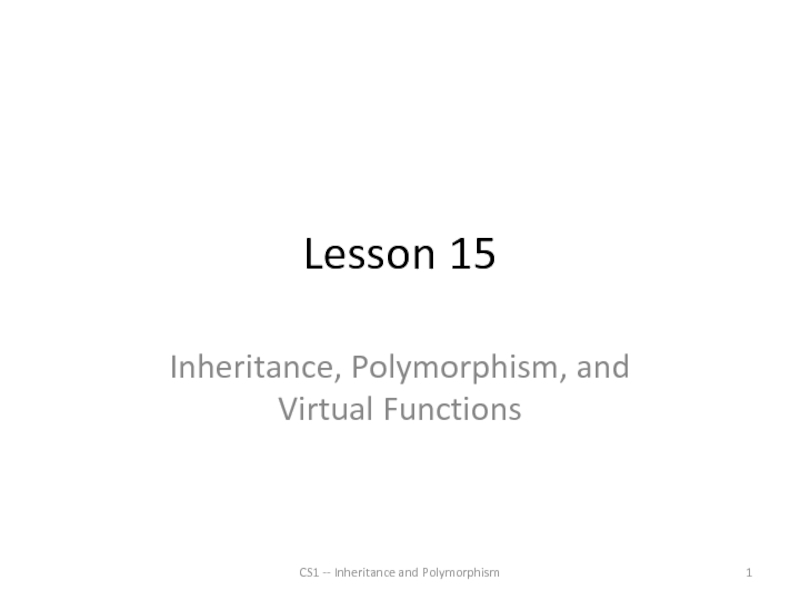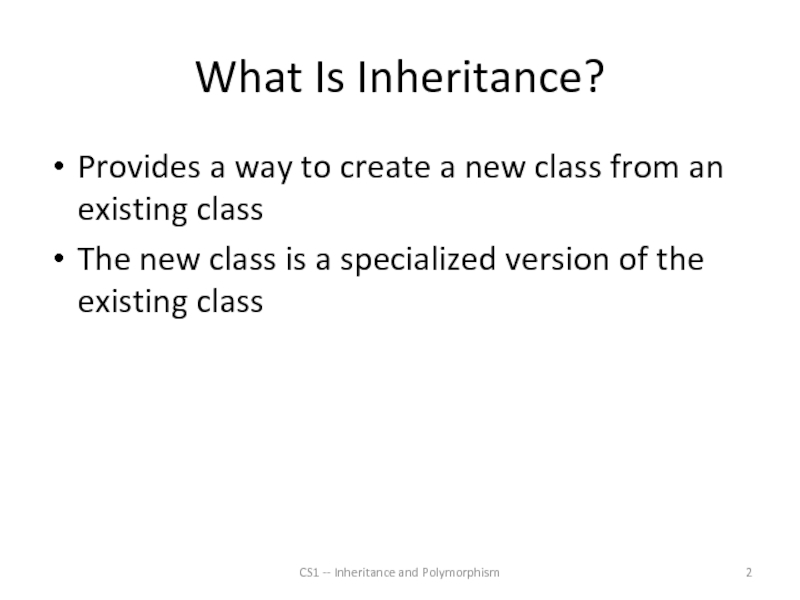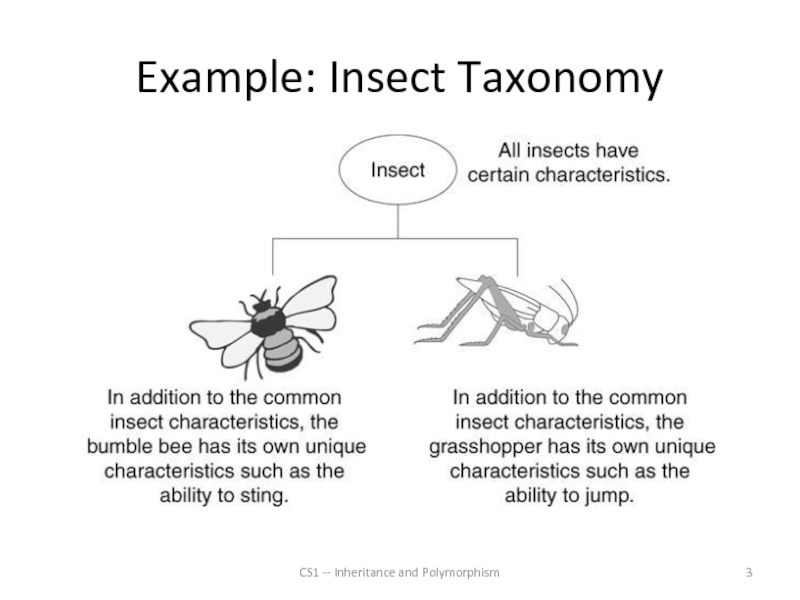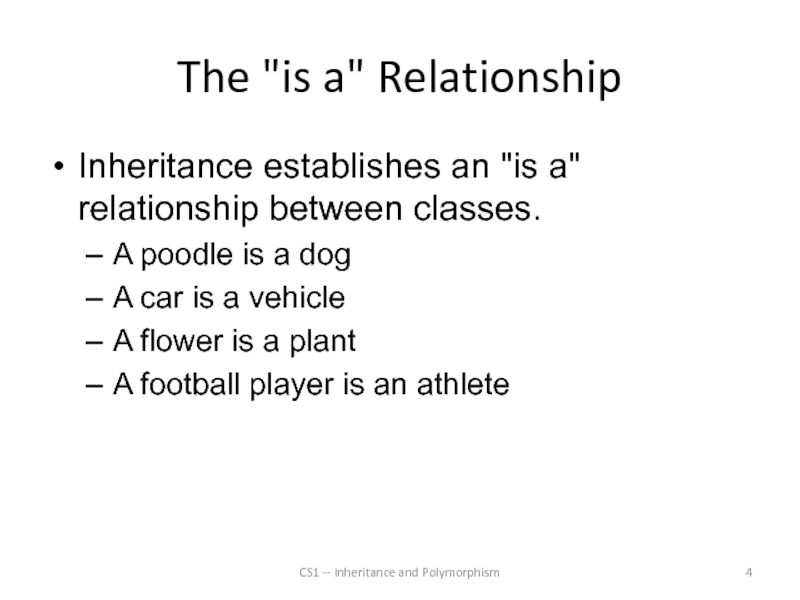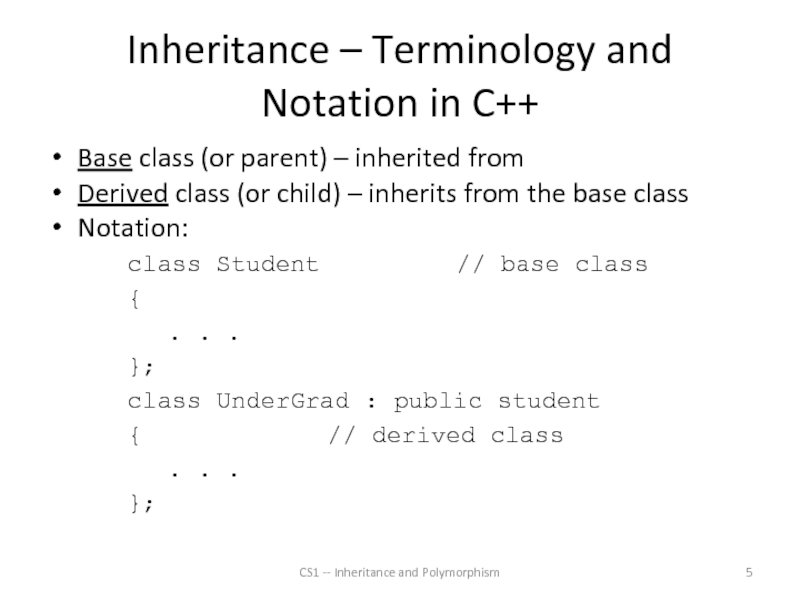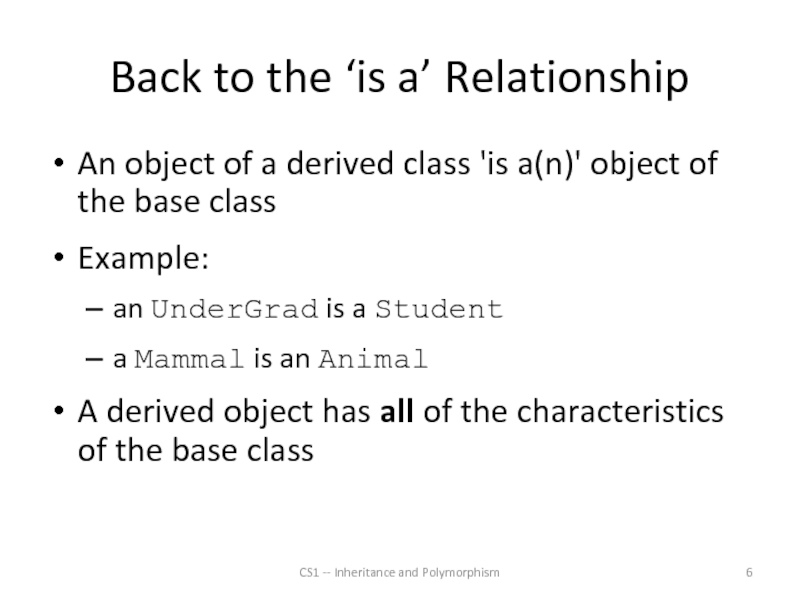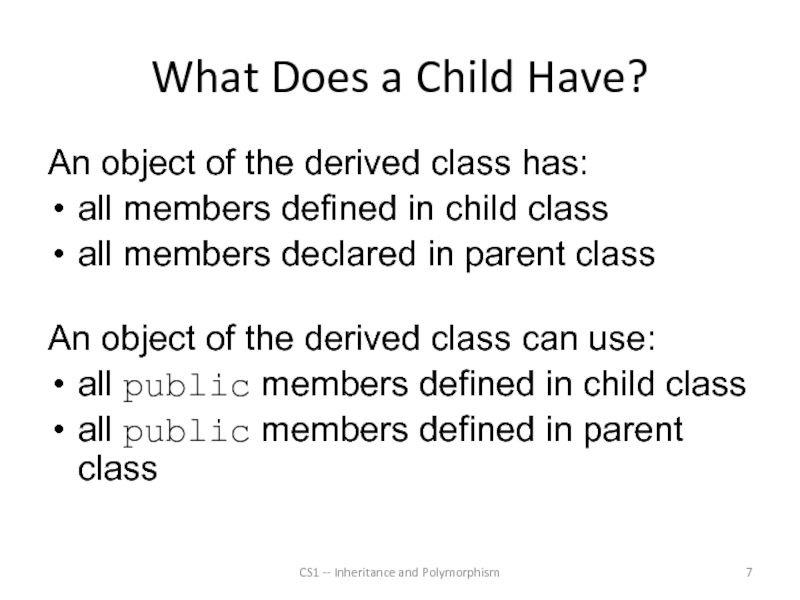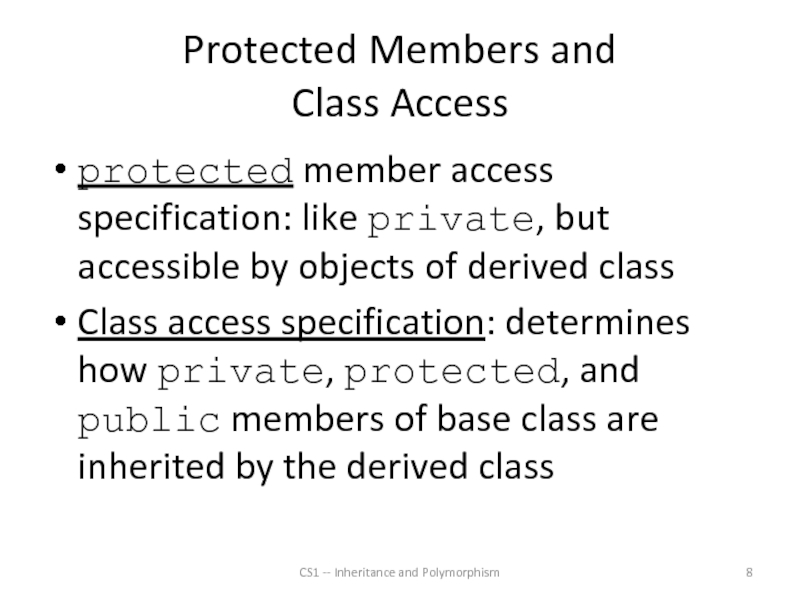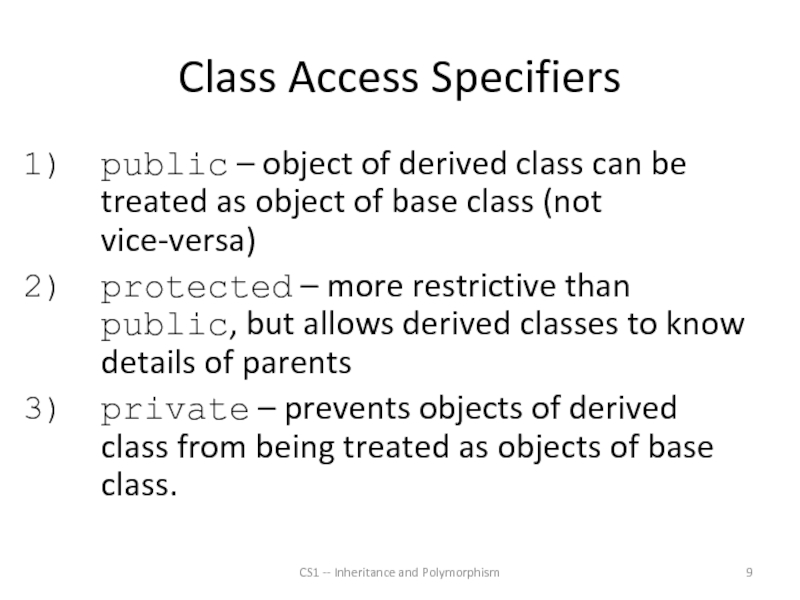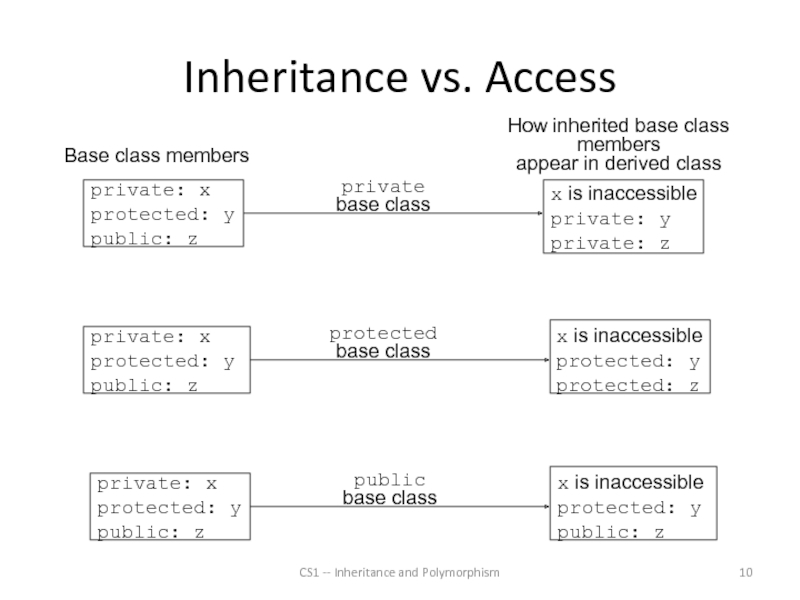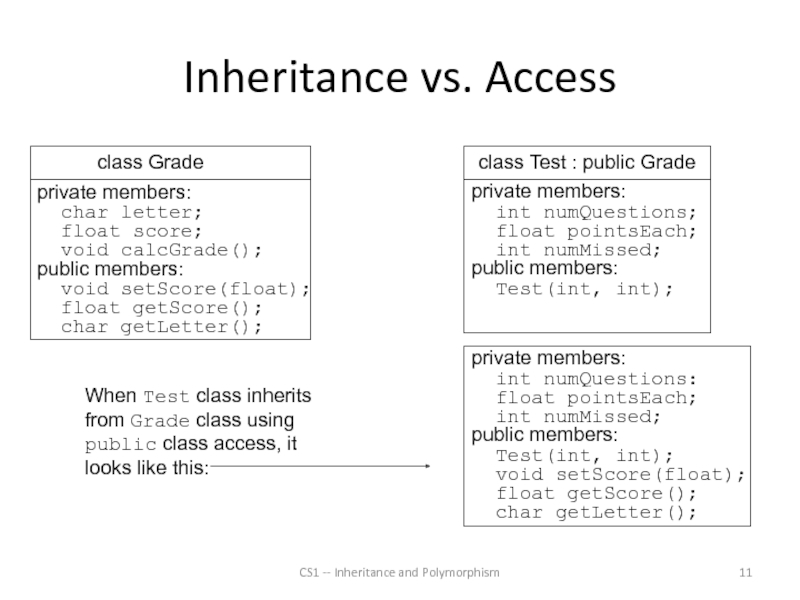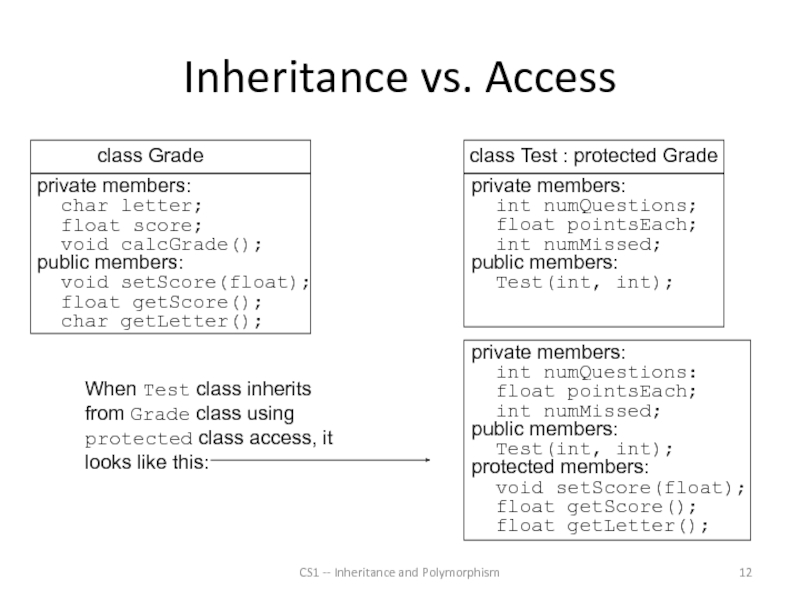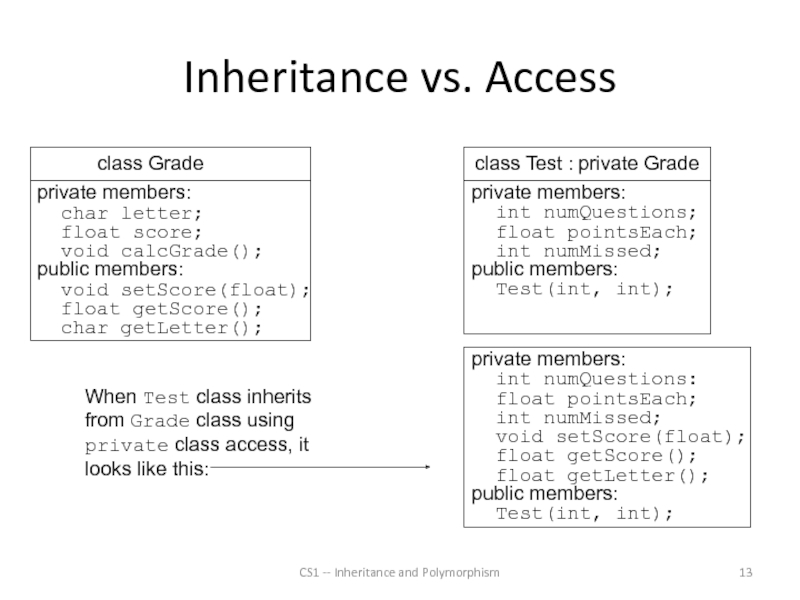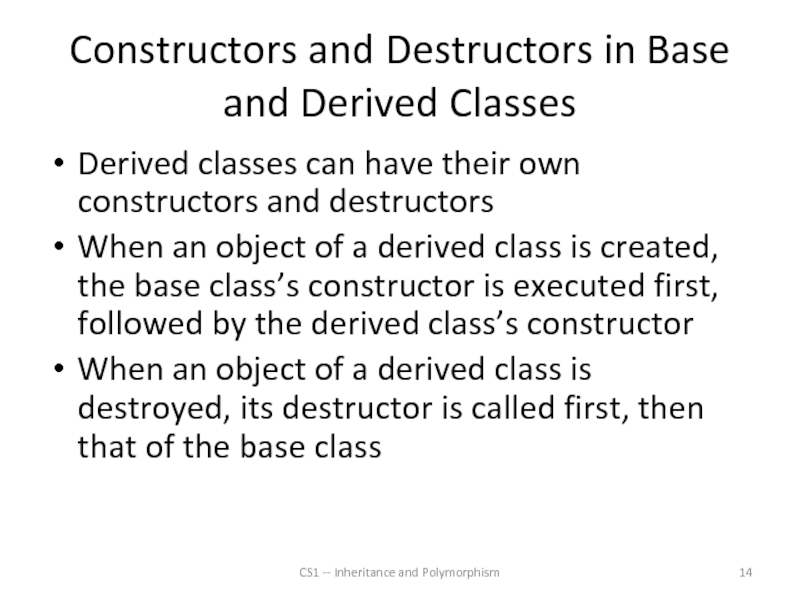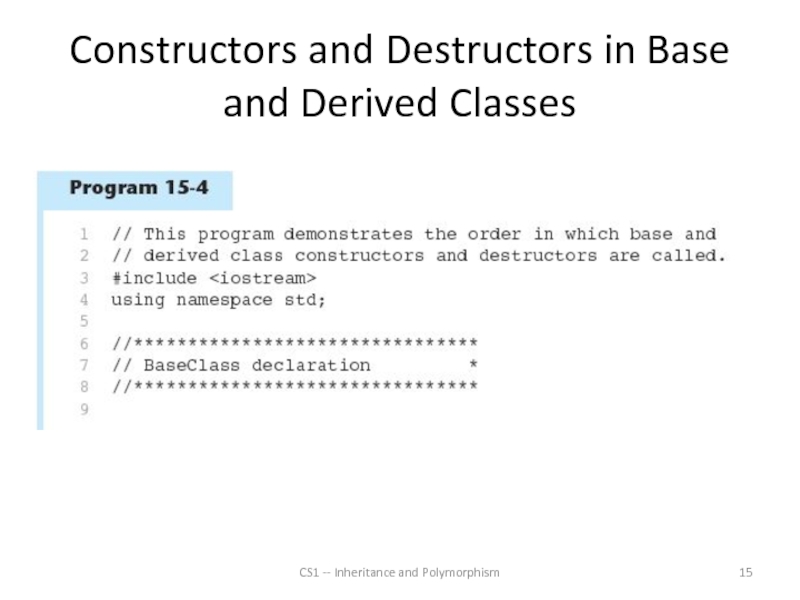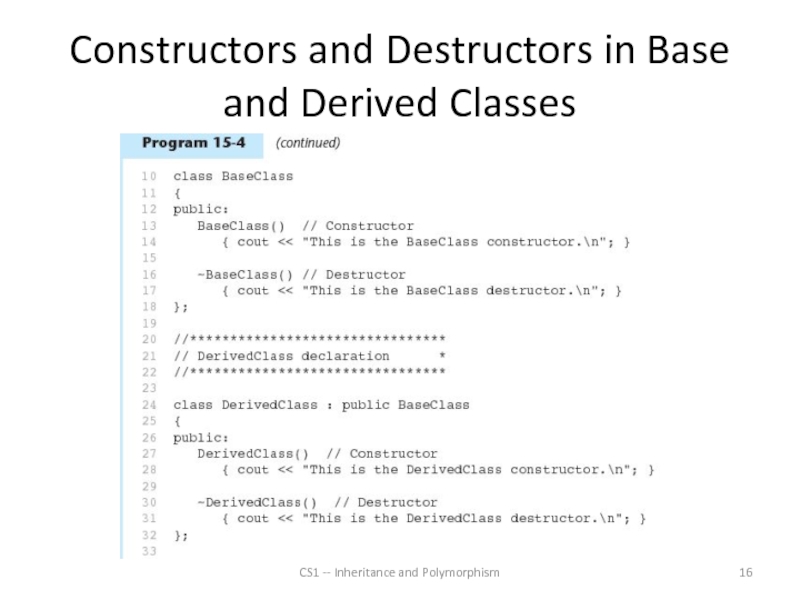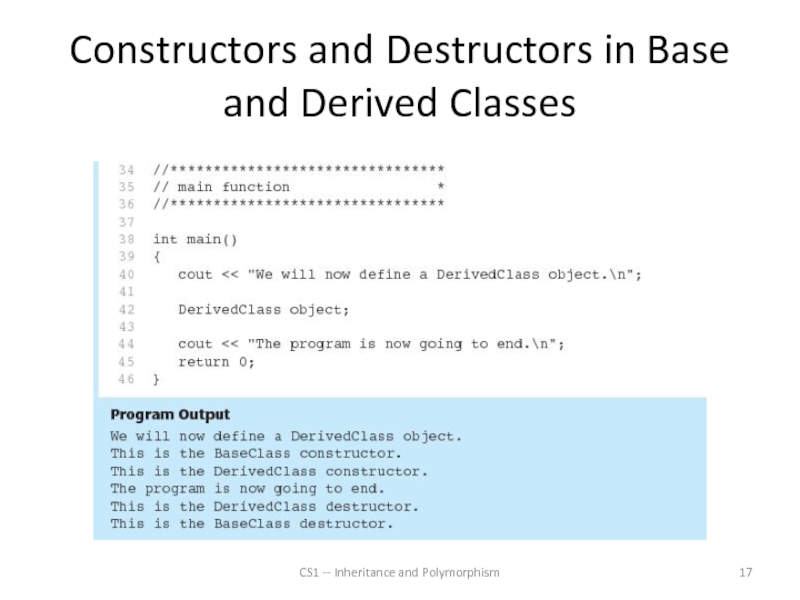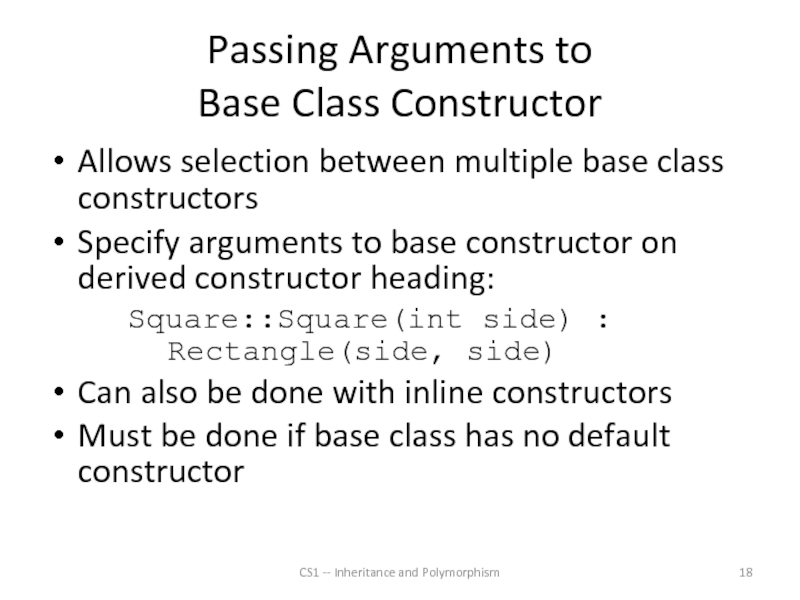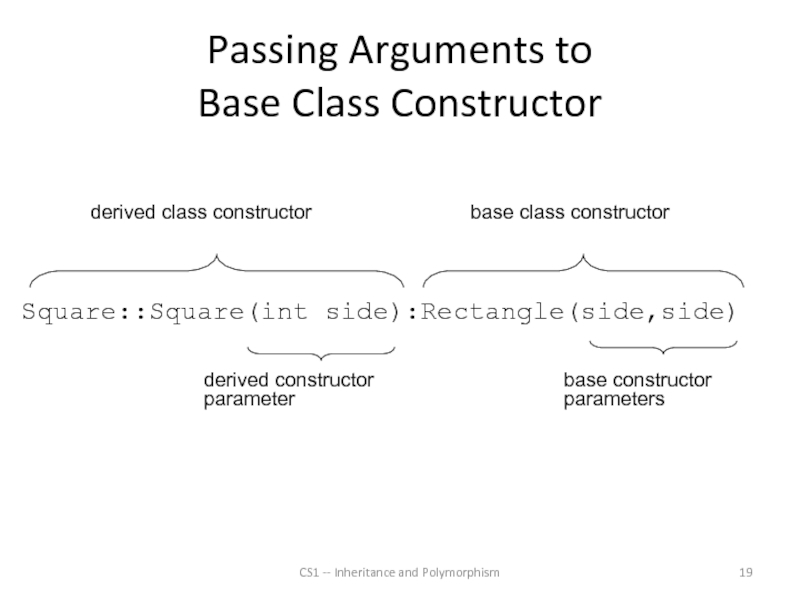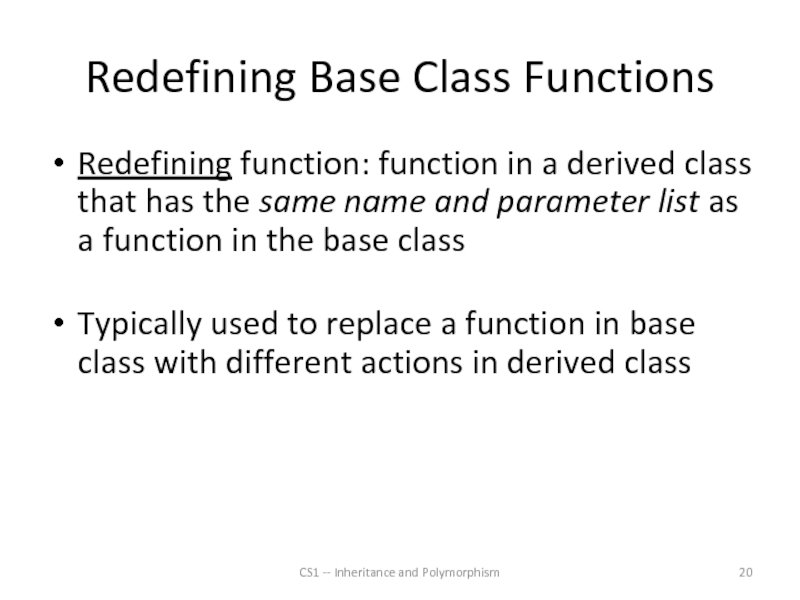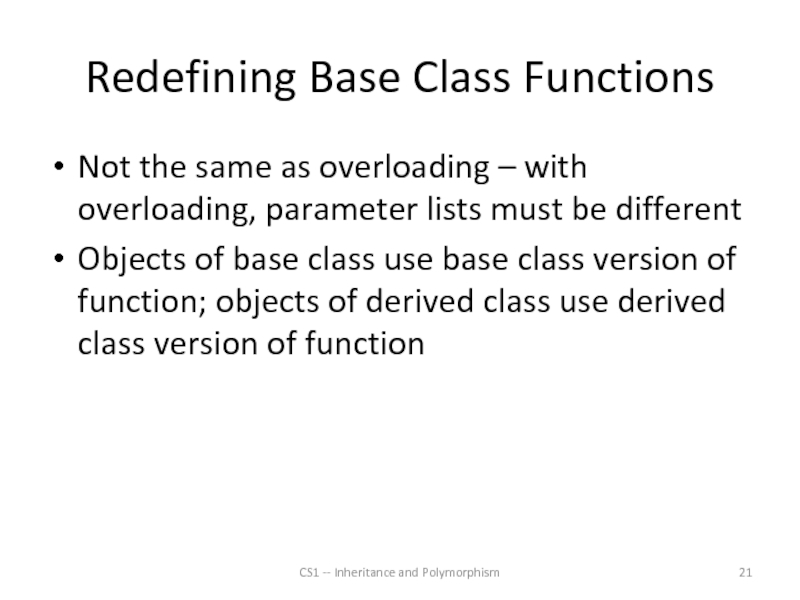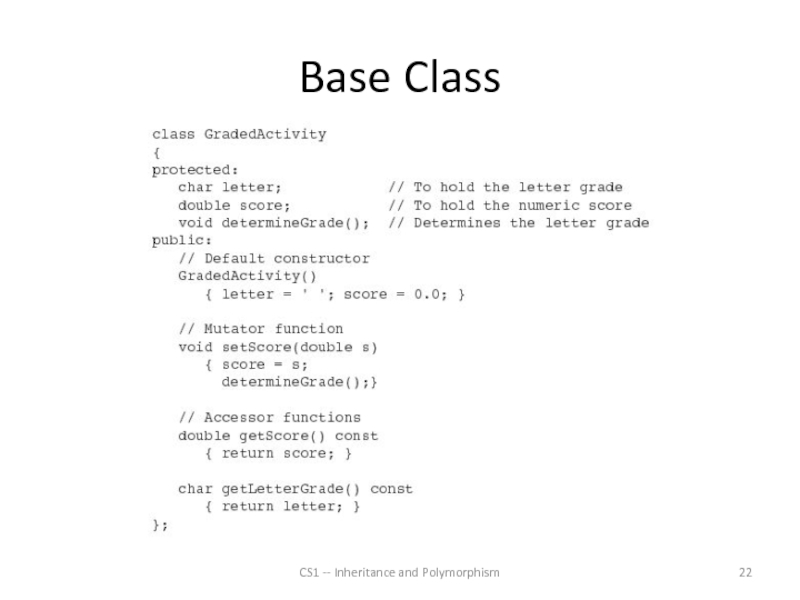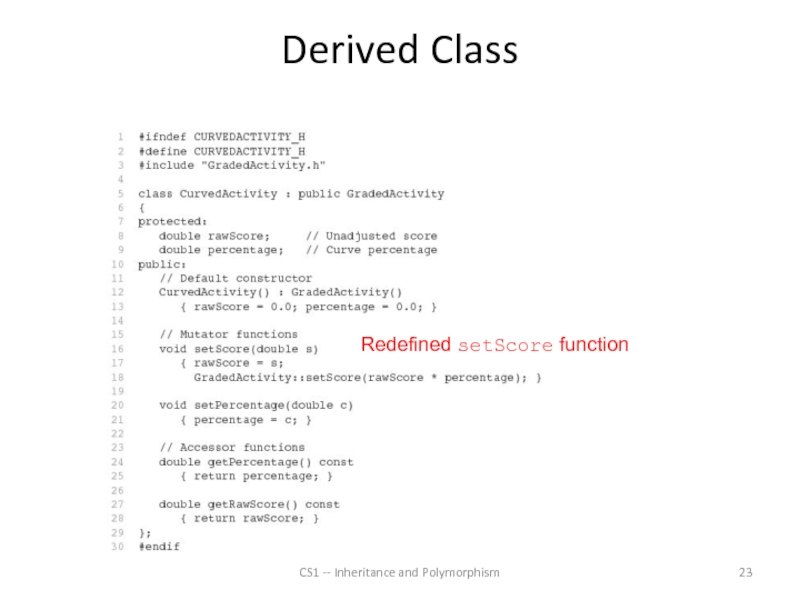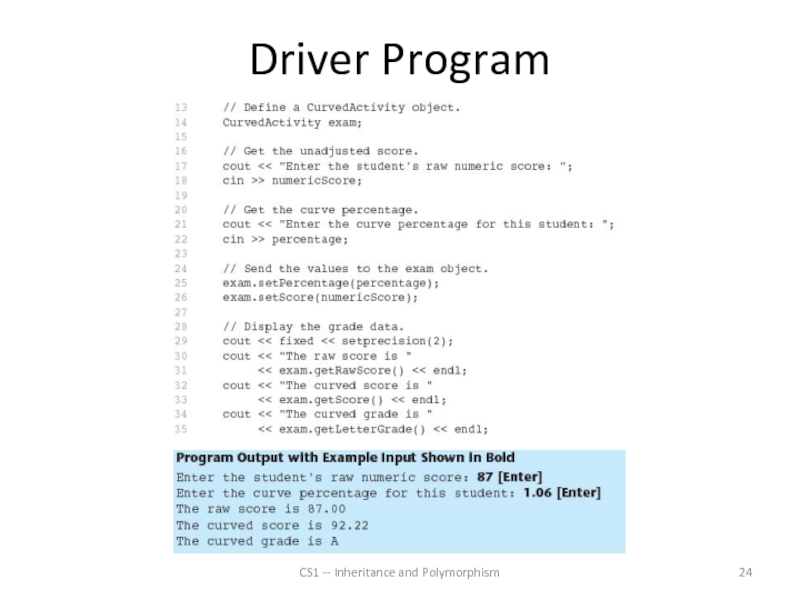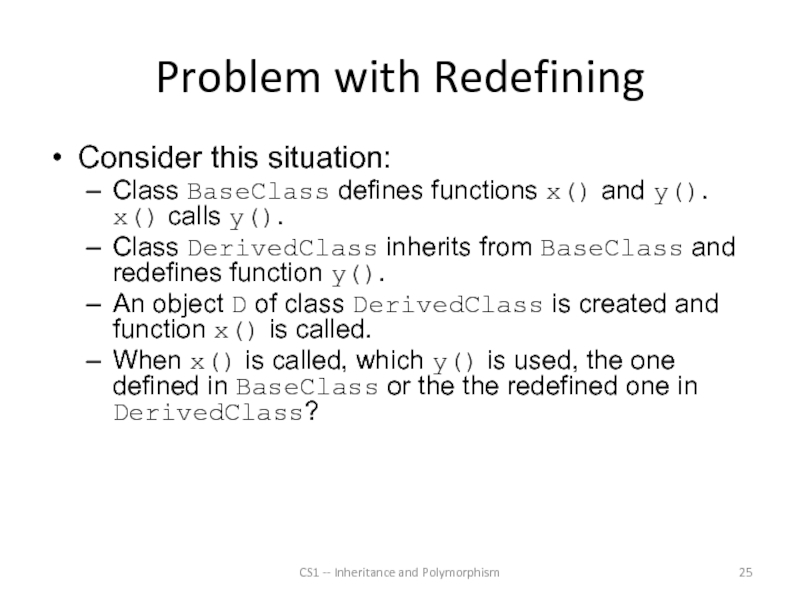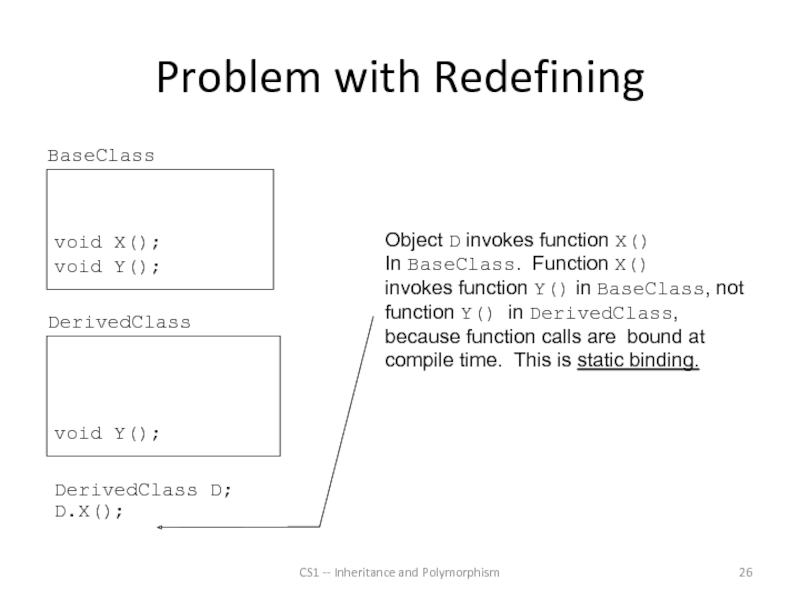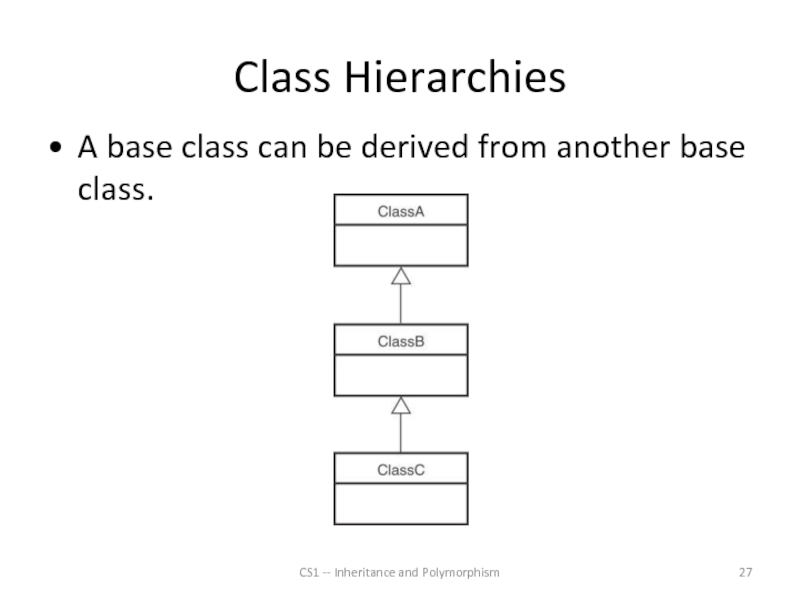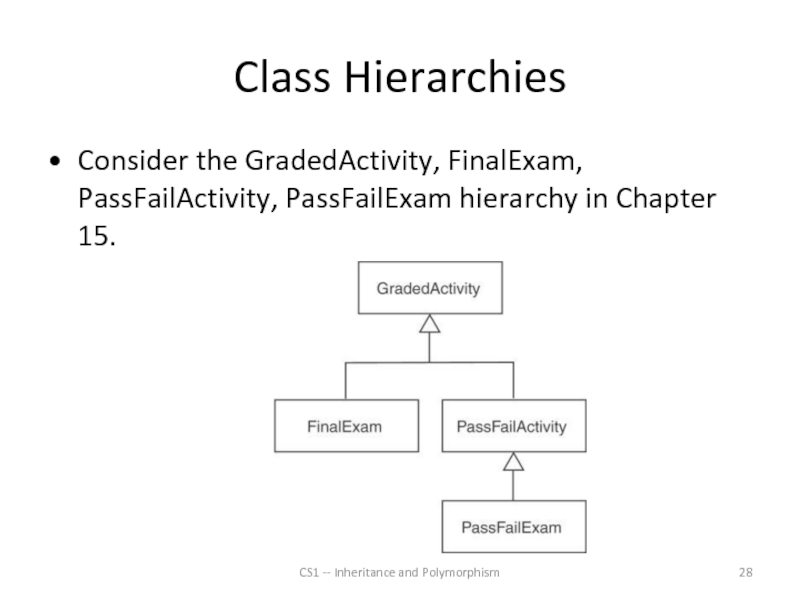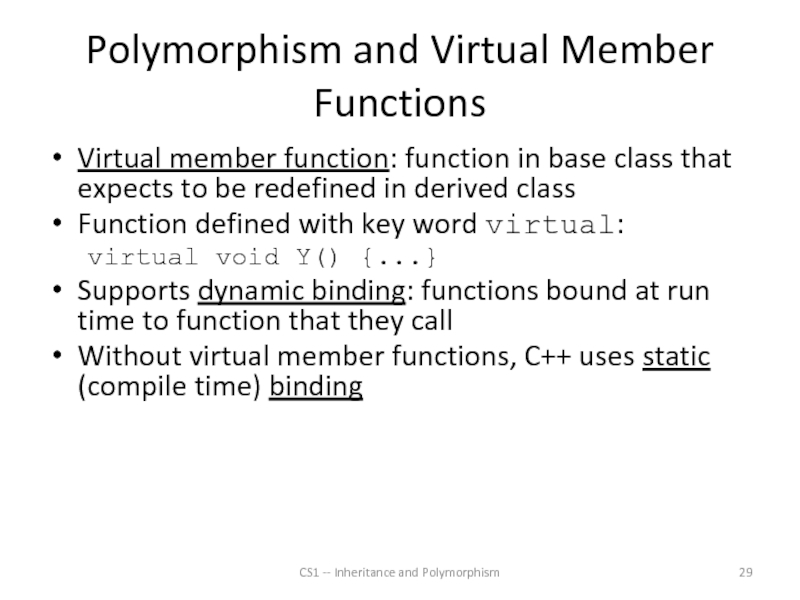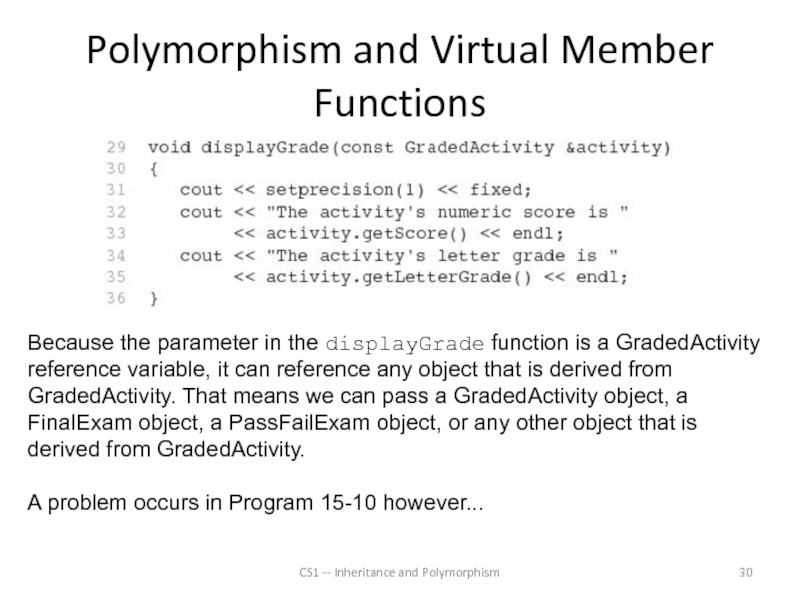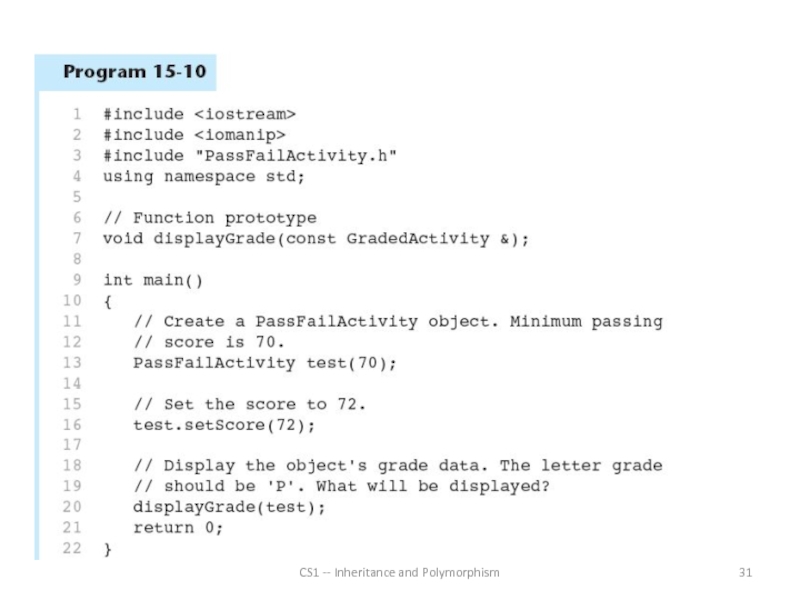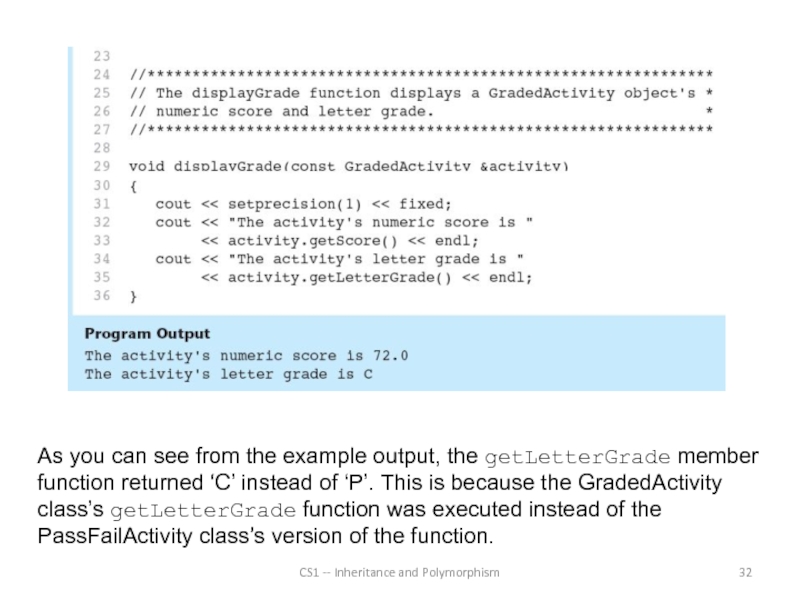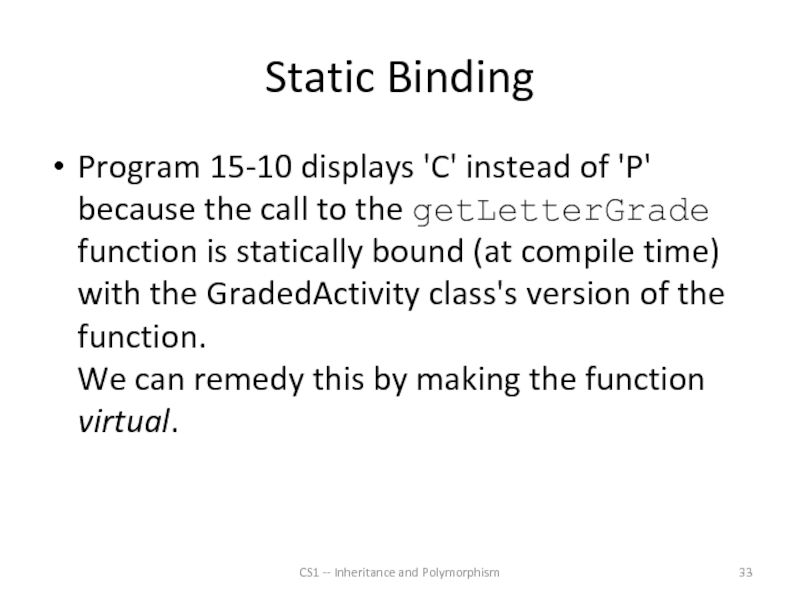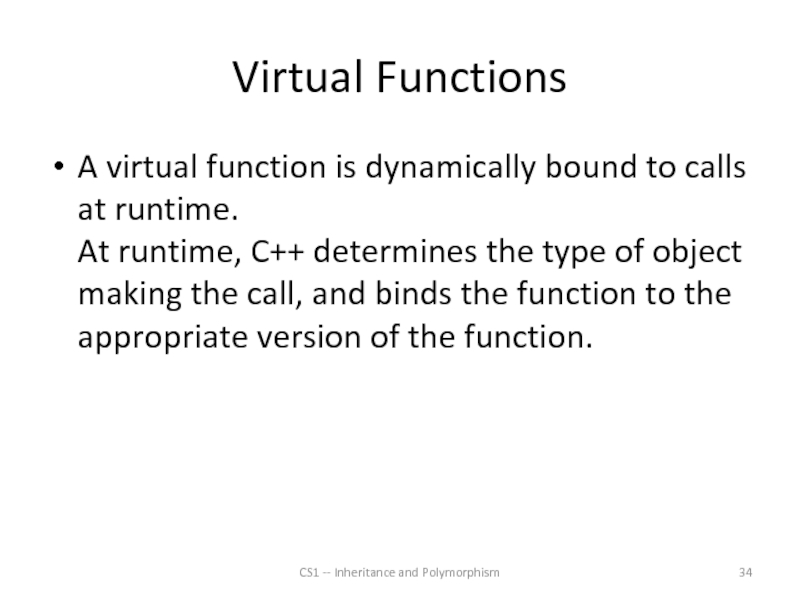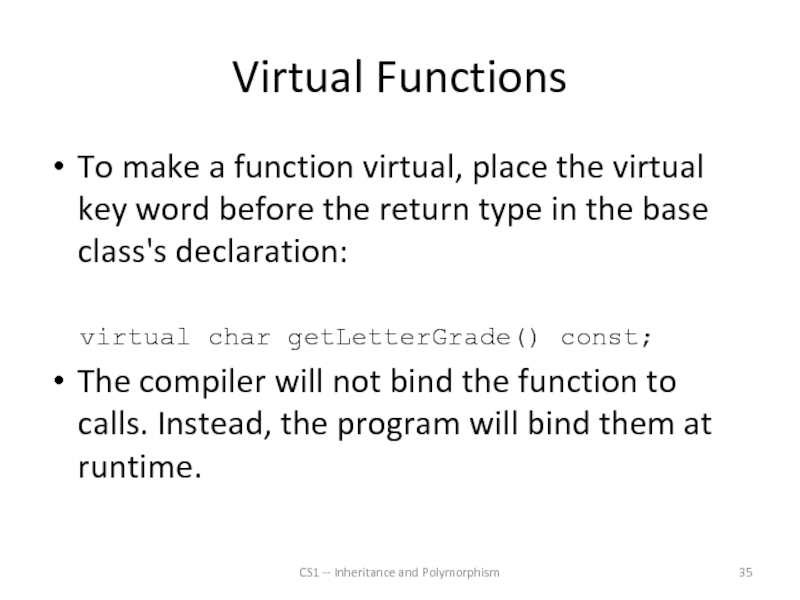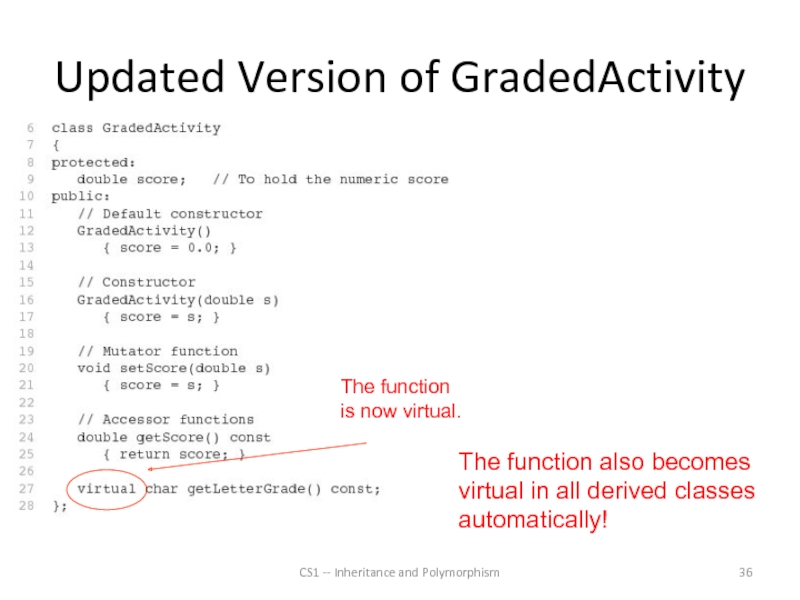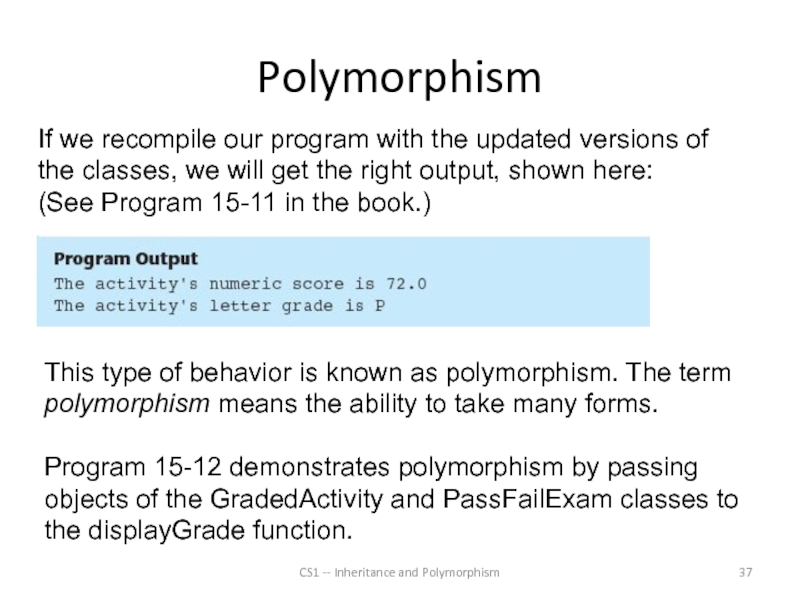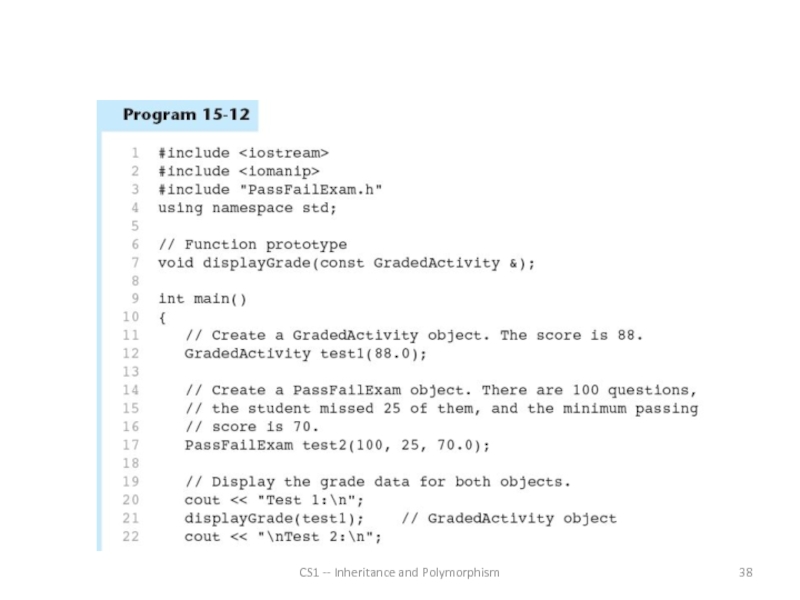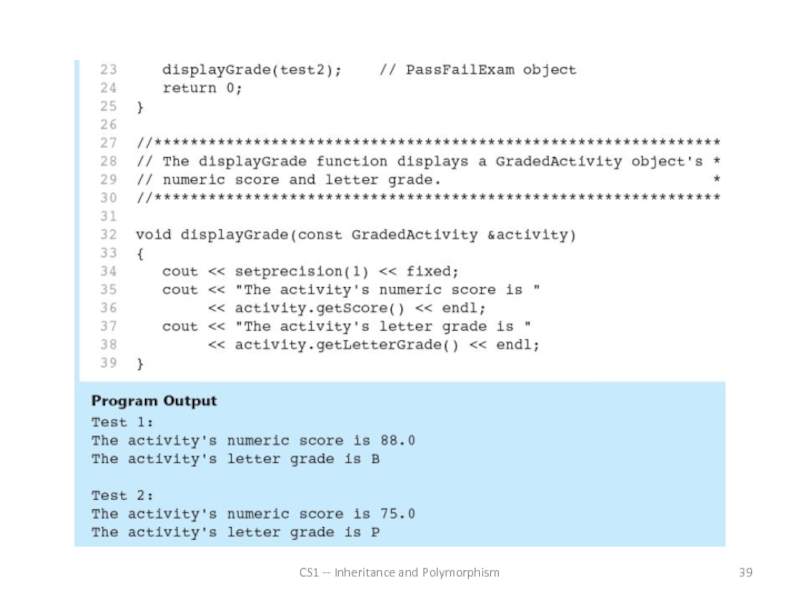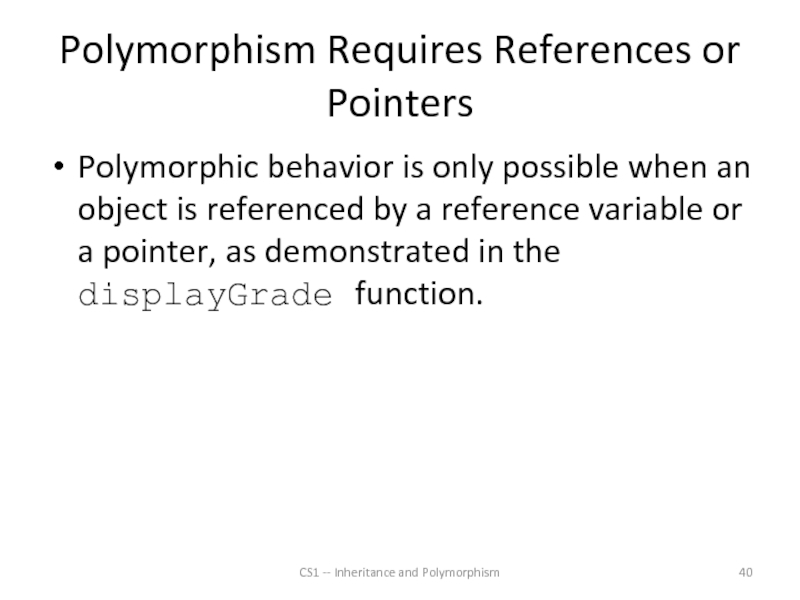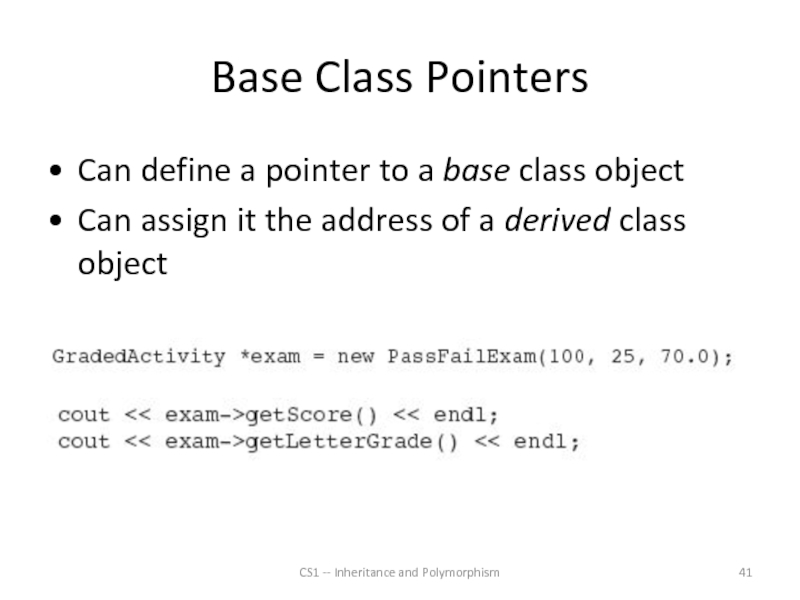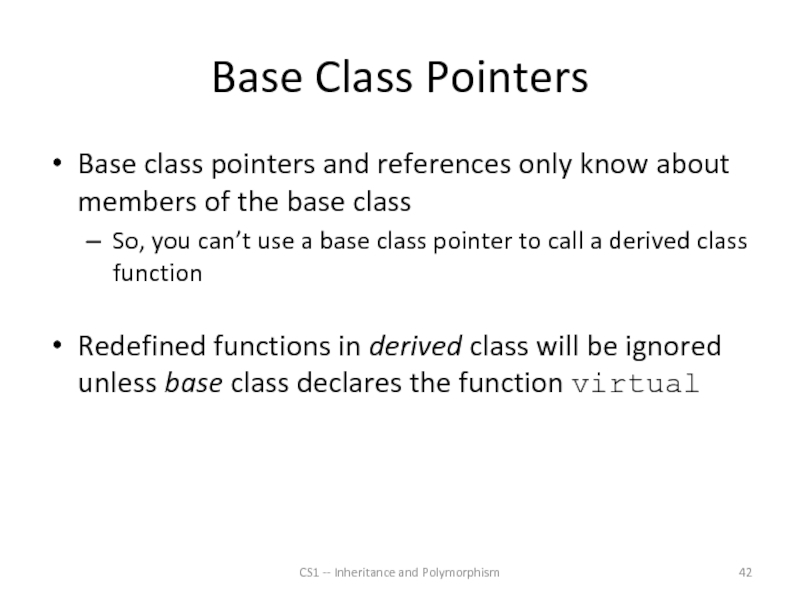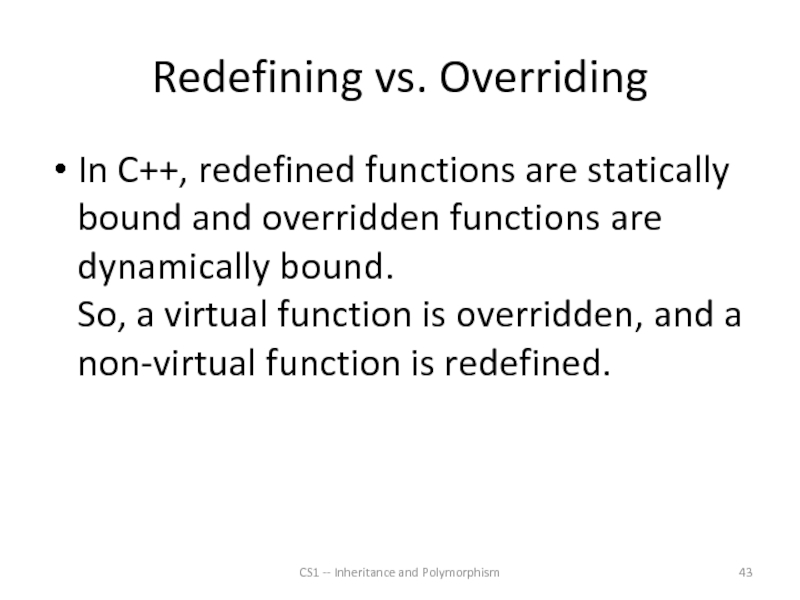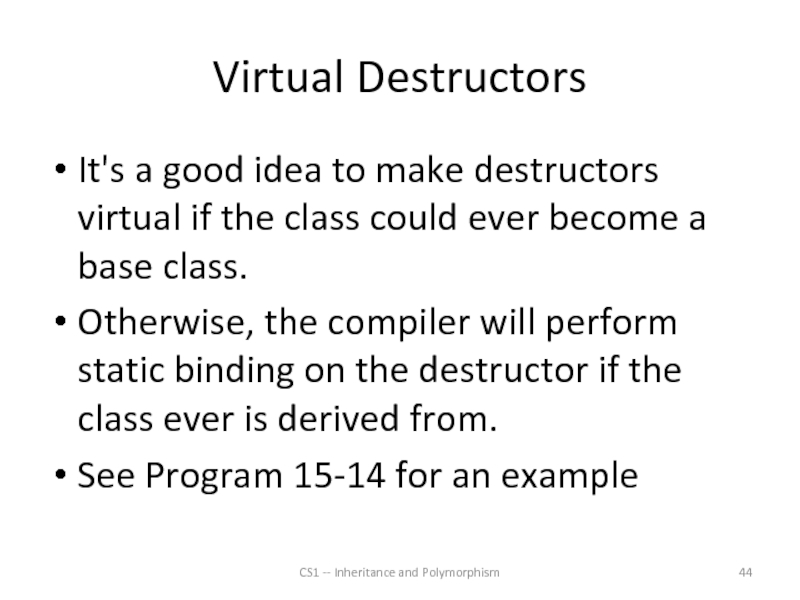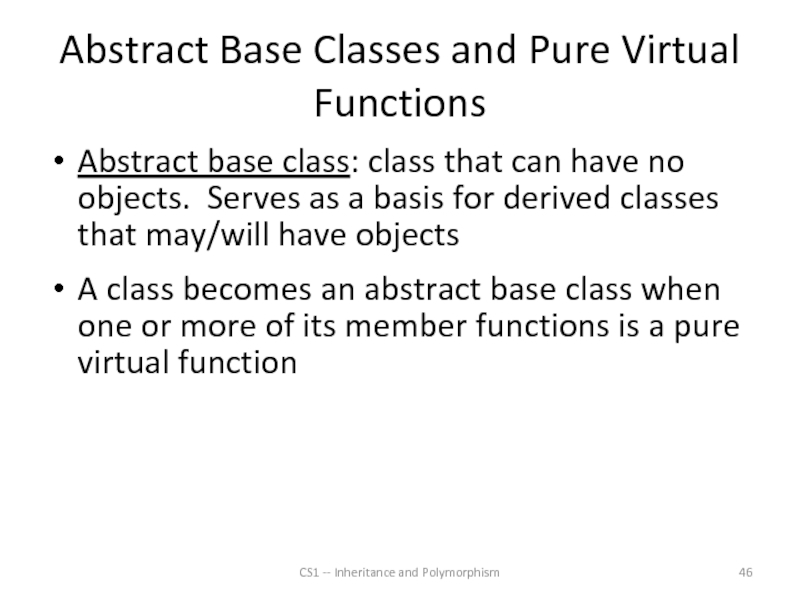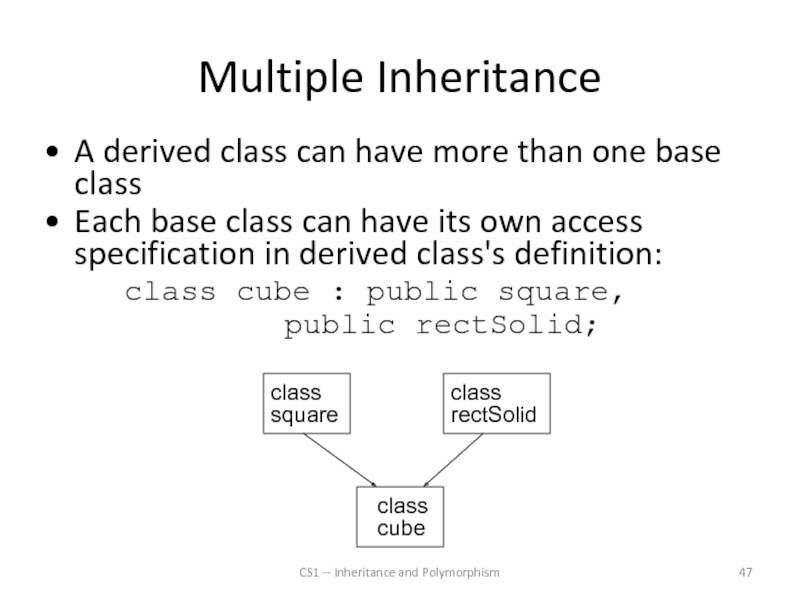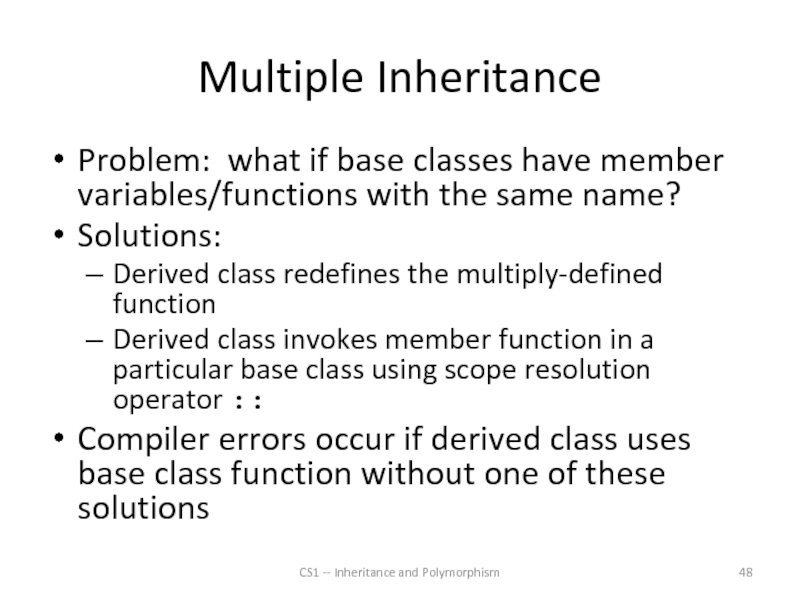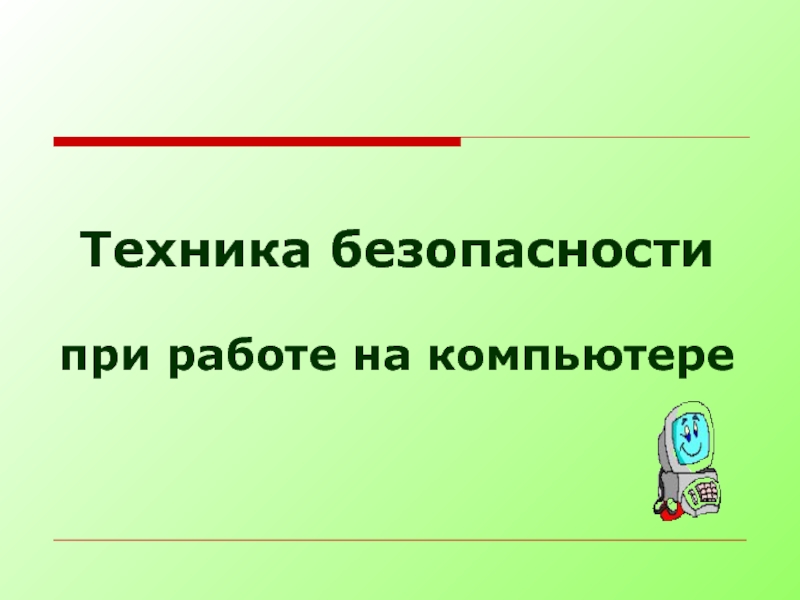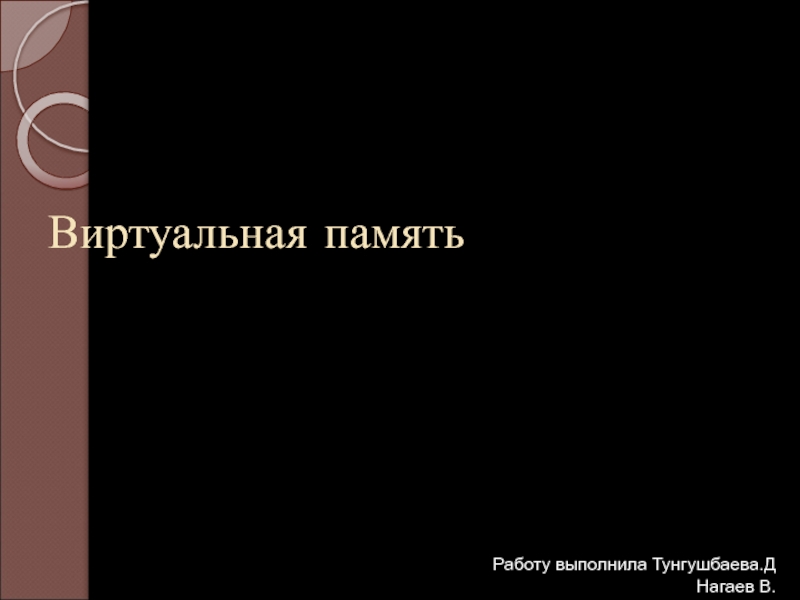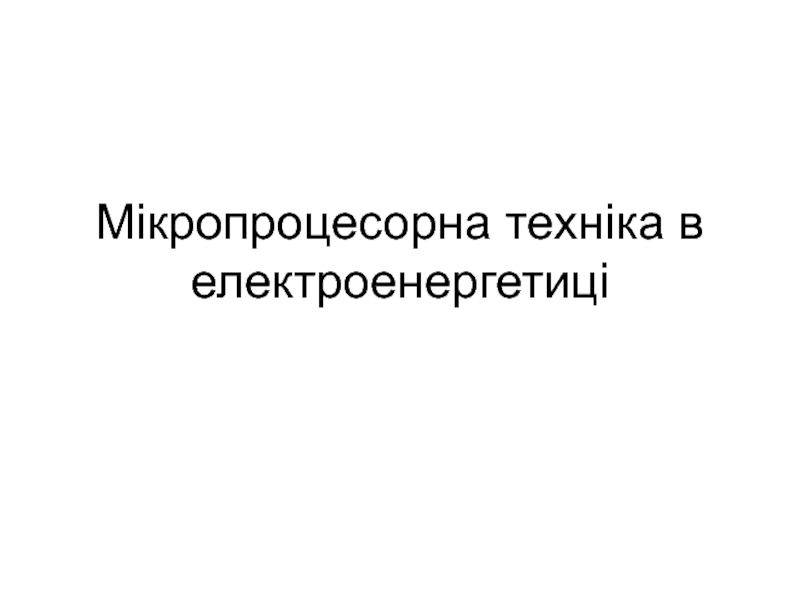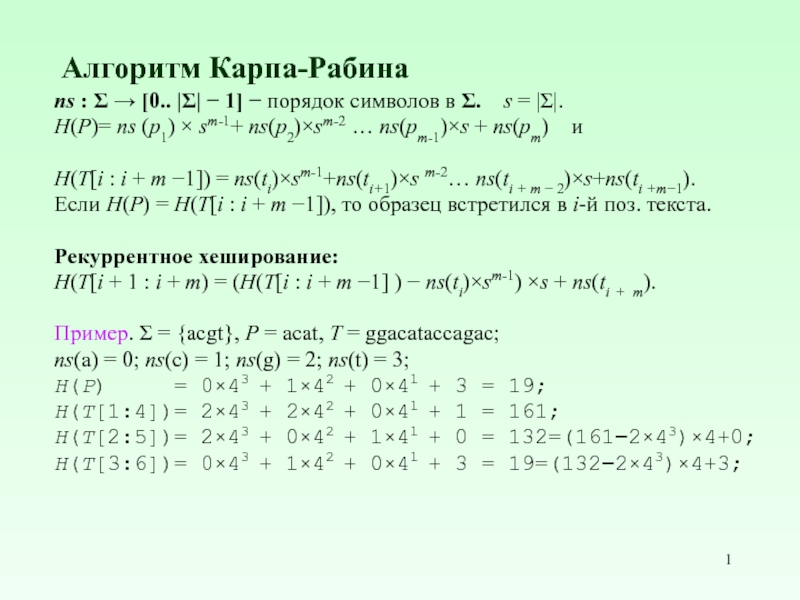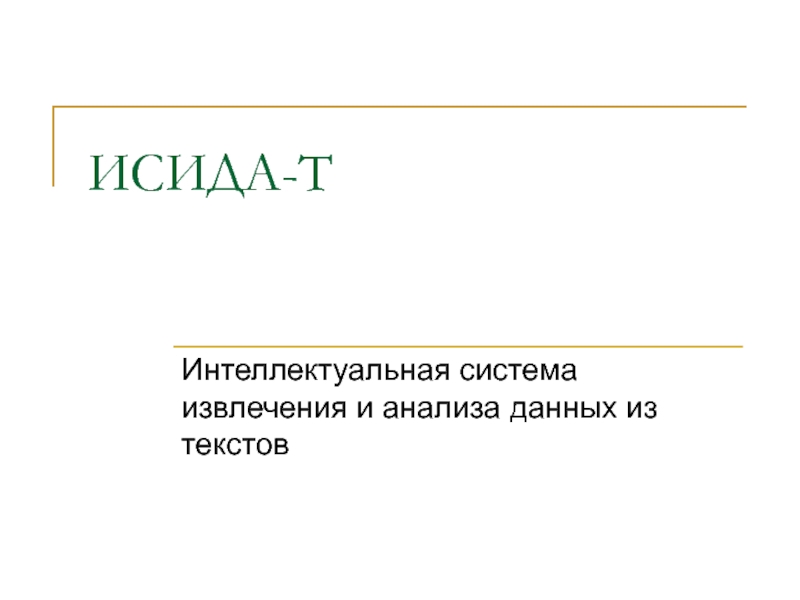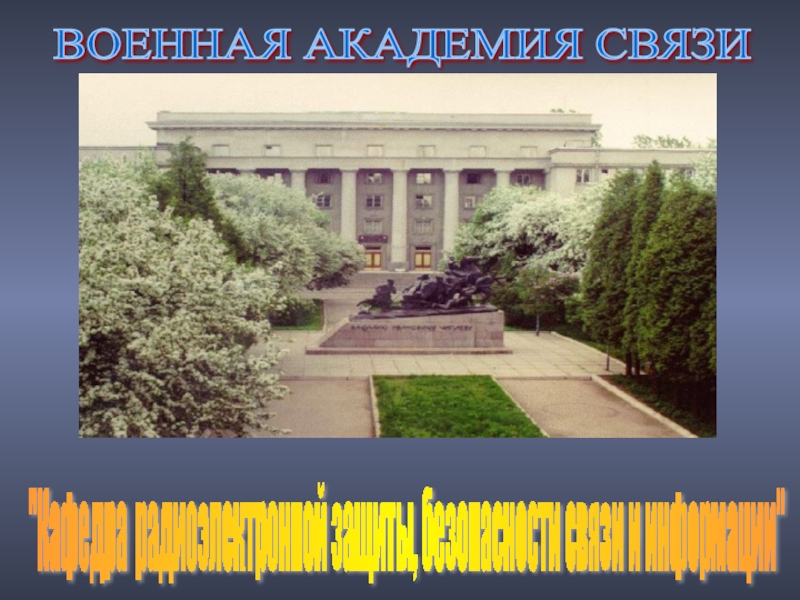- Главная
- Разное
- Дизайн
- Бизнес и предпринимательство
- Аналитика
- Образование
- Развлечения
- Красота и здоровье
- Финансы
- Государство
- Путешествия
- Спорт
- Недвижимость
- Армия
- Графика
- Культурология
- Еда и кулинария
- Лингвистика
- Английский язык
- Астрономия
- Алгебра
- Биология
- География
- Детские презентации
- Информатика
- История
- Литература
- Маркетинг
- Математика
- Медицина
- Менеджмент
- Музыка
- МХК
- Немецкий язык
- ОБЖ
- Обществознание
- Окружающий мир
- Педагогика
- Русский язык
- Технология
- Физика
- Философия
- Химия
- Шаблоны, картинки для презентаций
- Экология
- Экономика
- Юриспруденция
Nheritance, polymorphism, and virtual functions презентация
Содержание
- 1. Nheritance, polymorphism, and virtual functions
- 2. What Is Inheritance? Provides a way to
- 3. Example: Insect Taxonomy CS1 -- Inheritance and Polymorphism
- 4. The "is a" Relationship Inheritance establishes an
- 5. Inheritance – Terminology and Notation in C++
- 6. Back to the ‘is a’ Relationship An
- 7. What Does a Child Have? An object
- 8. Protected Members and
- 9. Class Access Specifiers public – object of
- 10. Inheritance vs. Access CS1 -- Inheritance and Polymorphism
- 11. Inheritance vs. Access CS1 -- Inheritance and Polymorphism
- 12. Inheritance vs. Access CS1 -- Inheritance and Polymorphism
- 13. Inheritance vs. Access CS1 -- Inheritance and Polymorphism
- 14. Constructors and Destructors in Base and Derived
- 15. Constructors and Destructors in Base and Derived Classes CS1 -- Inheritance and Polymorphism
- 16. Constructors and Destructors in Base and Derived Classes CS1 -- Inheritance and Polymorphism
- 17. Constructors and Destructors in Base and Derived Classes CS1 -- Inheritance and Polymorphism
- 18. Passing Arguments to Base Class Constructor
- 19. Passing Arguments to Base Class Constructor
- 20. Redefining Base Class Functions Redefining function: function
- 21. Redefining Base Class Functions Not the same
- 22. Base Class CS1 -- Inheritance and Polymorphism
- 23. Derived Class CS1 -- Inheritance and Polymorphism Redefined setScore function
- 24. Driver Program CS1 -- Inheritance and Polymorphism
- 25. Problem with Redefining Consider this situation: Class
- 26. Problem with Redefining CS1 -- Inheritance and
- 27. Class Hierarchies CS1 -- Inheritance and Polymorphism
- 28. Class Hierarchies CS1 -- Inheritance and Polymorphism
- 29. Polymorphism and Virtual Member Functions Virtual member
- 30. Polymorphism and Virtual Member Functions CS1 --
- 31. CS1 -- Inheritance and Polymorphism
- 32. CS1 -- Inheritance and Polymorphism As you
- 33. Static Binding Program 15-10 displays 'C' instead
- 34. Virtual Functions A virtual function is dynamically
- 35. Virtual Functions To make a function virtual,
- 36. Updated Version of GradedActivity CS1 -- Inheritance
- 37. Polymorphism CS1 -- Inheritance and Polymorphism If
- 38. CS1 -- Inheritance and Polymorphism
- 39. CS1 -- Inheritance and Polymorphism
- 40. Polymorphism Requires References or Pointers Polymorphic behavior
- 41. Base Class Pointers CS1 -- Inheritance and
- 42. Base Class Pointers Base class pointers and
- 43. Redefining vs. Overriding In C++, redefined functions
- 44. Virtual Destructors It's a good idea to
- 45. Abstract Base Classes and Pure Virtual Functions
- 46. Abstract Base Classes and Pure Virtual Functions
- 47. Multiple Inheritance CS1 -- Inheritance and Polymorphism
- 48. Multiple Inheritance Problem: what if base classes
Слайд 2What Is Inheritance?
Provides a way to create a new class from
The new class is a specialized version of the existing class
CS1 -- Inheritance and Polymorphism
Слайд 4The "is a" Relationship
Inheritance establishes an "is a" relationship between classes.
A
A car is a vehicle
A flower is a plant
A football player is an athlete
CS1 -- Inheritance and Polymorphism
Слайд 5Inheritance – Terminology and Notation in C++
Base class (or parent) –
Derived class (or child) – inherits from the base class
Notation:
class Student // base class
{
. . .
};
class UnderGrad : public student
{ // derived class
. . .
};
CS1 -- Inheritance and Polymorphism
Слайд 6Back to the ‘is a’ Relationship
An object of a derived class
Example:
an UnderGrad is a Student
a Mammal is an Animal
A derived object has all of the characteristics of the base class
CS1 -- Inheritance and Polymorphism
Слайд 7What Does a Child Have?
An object of the derived class has:
all
all members declared in parent class
An object of the derived class can use:
all public members defined in child class
all public members defined in parent class
CS1 -- Inheritance and Polymorphism
Слайд 8Protected Members and
protected member access specification: like private, but accessible by objects of derived class
Class access specification: determines how private, protected, and public members of base class are inherited by the derived class
CS1 -- Inheritance and Polymorphism
Слайд 9Class Access Specifiers
public – object of derived class can be treated
protected – more restrictive than public, but allows derived classes to know details of parents
private – prevents objects of derived class from being treated as objects of base class.
CS1 -- Inheritance and Polymorphism
Слайд 14Constructors and Destructors in Base and Derived Classes
Derived classes can have
When an object of a derived class is created, the base class’s constructor is executed first, followed by the derived class’s constructor
When an object of a derived class is destroyed, its destructor is called first, then that of the base class
CS1 -- Inheritance and Polymorphism
Слайд 18Passing Arguments to
Base Class Constructor
Allows selection between multiple base class
Specify arguments to base constructor on derived constructor heading:
Square::Square(int side) : Rectangle(side, side)
Can also be done with inline constructors
Must be done if base class has no default constructor
CS1 -- Inheritance and Polymorphism
Слайд 19Passing Arguments to
Base Class Constructor
CS1 -- Inheritance and Polymorphism
Square::Square(int side):Rectangle(side,side)
derived
base class constructor
derived constructor parameter
base constructor parameters
Слайд 20Redefining Base Class Functions
Redefining function: function in a derived class that
Typically used to replace a function in base class with different actions in derived class
CS1 -- Inheritance and Polymorphism
Слайд 21Redefining Base Class Functions
Not the same as overloading – with overloading,
Objects of base class use base class version of function; objects of derived class use derived class version of function
CS1 -- Inheritance and Polymorphism
Слайд 25Problem with Redefining
Consider this situation:
Class BaseClass defines functions x() and y().
Class DerivedClass inherits from BaseClass and redefines function y().
An object D of class DerivedClass is created and function x() is called.
When x() is called, which y() is used, the one defined in BaseClass or the the redefined one in DerivedClass?
CS1 -- Inheritance and Polymorphism
Слайд 26Problem with Redefining
CS1 -- Inheritance and Polymorphism
BaseClass
DerivedClass
void X();
void Y();
void Y();
DerivedClass D;
D.X();
Object
In BaseClass. Function X()
invokes function Y() in BaseClass, not function Y() in DerivedClass,
because function calls are bound at compile time. This is static binding.
Слайд 27Class Hierarchies
CS1 -- Inheritance and Polymorphism
A base class can be derived
Слайд 28Class Hierarchies
CS1 -- Inheritance and Polymorphism
Consider the GradedActivity, FinalExam, PassFailActivity, PassFailExam
Слайд 29Polymorphism and Virtual Member Functions
Virtual member function: function in base class
Function defined with key word virtual:
virtual void Y() {...}
Supports dynamic binding: functions bound at run time to function that they call
Without virtual member functions, C++ uses static (compile time) binding
CS1 -- Inheritance and Polymorphism
Слайд 30Polymorphism and Virtual Member Functions
CS1 -- Inheritance and Polymorphism
Because the parameter
A problem occurs in Program 15-10 however...
Слайд 32CS1 -- Inheritance and Polymorphism
As you can see from the example
Слайд 33Static Binding
Program 15-10 displays 'C' instead of 'P' because the call
CS1 -- Inheritance and Polymorphism
Слайд 34Virtual Functions
A virtual function is dynamically bound to calls at runtime.
At
CS1 -- Inheritance and Polymorphism
Слайд 35Virtual Functions
To make a function virtual, place the virtual key word
virtual char getLetterGrade() const;
The compiler will not bind the function to calls. Instead, the program will bind them at runtime.
CS1 -- Inheritance and Polymorphism
Слайд 36Updated Version of GradedActivity
CS1 -- Inheritance and Polymorphism
The function
The function also becomes virtual in all derived classes automatically!
Слайд 37Polymorphism
CS1 -- Inheritance and Polymorphism
If we recompile our program with the
This type of behavior is known as polymorphism. The term polymorphism means the ability to take many forms.
Program 15-12 demonstrates polymorphism by passing
objects of the GradedActivity and PassFailExam classes to the displayGrade function.
Слайд 40Polymorphism Requires References or Pointers
Polymorphic behavior is only possible when an
CS1 -- Inheritance and Polymorphism
Слайд 41Base Class Pointers
CS1 -- Inheritance and Polymorphism
Can define a pointer to
Can assign it the address of a derived class object
Слайд 42Base Class Pointers
Base class pointers and references only know about members
So, you can’t use a base class pointer to call a derived class function
Redefined functions in derived class will be ignored unless base class declares the function virtual
CS1 -- Inheritance and Polymorphism
Слайд 43Redefining vs. Overriding
In C++, redefined functions are statically bound and overridden
CS1 -- Inheritance and Polymorphism
Слайд 44Virtual Destructors
It's a good idea to make destructors virtual if the
Otherwise, the compiler will perform static binding on the destructor if the class ever is derived from.
See Program 15-14 for an example
CS1 -- Inheritance and Polymorphism
Слайд 45Abstract Base Classes and Pure Virtual Functions
Pure virtual function: a virtual
Abstract base class contains at least one pure virtual function:
virtual void Y() = 0;
The = 0 indicates a pure virtual function
Must have no function definition in the base class
CS1 -- Inheritance and Polymorphism
Слайд 46Abstract Base Classes and Pure Virtual Functions
Abstract base class: class that
A class becomes an abstract base class when one or more of its member functions is a pure virtual function
CS1 -- Inheritance and Polymorphism
Слайд 47Multiple Inheritance
CS1 -- Inheritance and Polymorphism
A derived class can have more
Each base class can have its own access specification in derived class's definition:
class cube : public square,
public rectSolid;
Слайд 48Multiple Inheritance
Problem: what if base classes have member variables/functions with the
Solutions:
Derived class redefines the multiply-defined function
Derived class invokes member function in a particular base class using scope resolution operator ::
Compiler errors occur if derived class uses base class function without one of these solutions
CS1 -- Inheritance and Polymorphism
